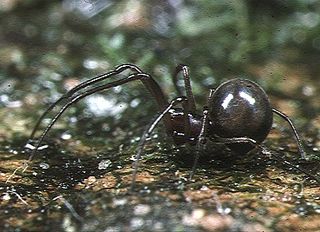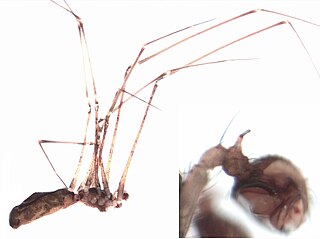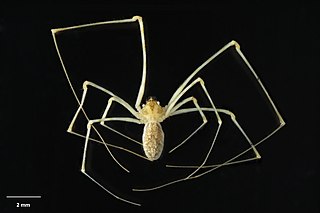
Orsolobidae is a six-eyed spider family with about 180 described species in thirty genera. It was first described by J. A. L. Cooke in 1965, and was raised to family status from "Dysderidae" in 1985.

Anapidae is a family of rather small spiders with 231 described species in 58 genera. It includes the former family Micropholcommatidae as the subfamily Micropholcommatinae, and the former family Holarchaeidae. Most species are less than 2 millimetres (0.079 in) long.

Symphytognathidae is a family of spiders with 90 described species in eight genera. They occur in the tropics of Central and South America and the Australian region. Exceptions include Anapistula benoiti, Anapistula caecula, and Symphytognatha imbulunga, found in Africa, Anapistula ishikawai, found in Japan, and Anapistula jerai, found in Southeast Asia.

Araneoidea is a taxon of araneomorph spiders, termed "araneoids", treated as a superfamily. As with many such groups, its circumscription has varied; in particular some families that had at one time moved to the Palpimanoidea have more recently been restored to Araneoidea. A 2014 treatment includes 18 families, with the araneoids making up about 26% of the total number of known spider species; a 2016 treatment includes essentially the same taxa, but now divided into 17 families.
Runga is a genus of Polynesian araneomorph spiders in the family Physoglenidae that was first described by Raymond Robert Forster in 1990.
Maxanapis is a genus of Australian araneomorph spiders in the family Anapidae, first described by Norman I. Platnick & Raymond Robert Forster in 1989.
Minanapis is a genus of araneomorph spiders in the family Anapidae, first described by Norman I. Platnick & Raymond Robert Forster in 1989.
Calcarsynotaxus is a genus of Australian araneomorph spiders in the family Physoglenidae, and was first described by J. Wunderlich in 1995. As of September 2019 it contains two species, found in Queensland and Western Australia: C. benrobertsi and C. longipes.
Chileotaxus is a monotypic genus of Chilean araneomorph spiders in the family Physoglenidae, containing the single species Chileotaxus sans. It was first described by Norman I. Platnick in 1990, and is found in Chile. Originally placed with the Synotaxidae, it was moved to the Physoglenidae in 1973. The generic name is a contraction of "Chilean Synotaxus", and the specific name is an arbitrary combination of letters.
Mangua is a genus of araneomorph spiders in the family Physoglenidae that first described by Raymond Robert Forster in 1990. Originally placed with the Synotaxidae, it was moved to the Stiphidiidae in 2017.

Meringa is a genus of Polynesian araneomorph spiders in the family Physoglenidae that was first described by Raymond Robert Forster in 1990. Originally placed with the Synotaxidae, it was moved to the Physoglenidae in 2017.

Nomaua is a genus of Polynesian araneomorph spiders in the family Physoglenidae that was first described by Raymond Robert Forster in 1990. Originally placed with the Linyphiidae, it was moved to the Synotaxidae in 1990, and is now considered a senior synonym of Wairua.
Pahora is a genus of Polynesian araneomorph spiders in the family Physoglenidae that was first described by Raymond Robert Forster in 1990. Originally placed with the Synotaxidae, it was moved to the Physoglenidae in 2017.

Pahoroides is a genus of Polynesian araneomorph spiders in the family Physoglenidae that was first described by Raymond Robert Forster in 1990.
Paratupua is a monotypic genus of araneomorph spiders in the family Physoglenidae found in Victoria, Australia. It contains the single species, Paratupua grayi. Though it's sometimes misspelled Paratupa, the correct spelling is "Paratupua".
Physoglenes is a genus of Chilean araneomorph spiders in the family Physoglenidae that was first described by Eugène Louis Simon in 1904. It has been listed under several different families, including Leptonetidae, Pholcidae, Synotaxidae, and most recently, Physoglenidae.
Synotaxus is a genus of araneomorph spiders in the family Synotaxidae that was first described by Eugène Louis Simon in 1895. Originally placed with the tangle web spiders, it was moved to the monotypic family Synotaxidae in 2017.
Zeatupua is a monotypic genus of araneomorph spiders in the family Physoglenidae containing the single species, Zeatupua forsteri. It was first described by Fitzgerald & Sirvid in 2009, and is found in New Zealand. Originally placed with the Synotaxidae, it was moved to the Physoglenidae in 2017.
Tupua is a genus of Tasmanian araneomorph spiders in the family Physoglenidae that was first described by Norman I. Platnick in 1990.







